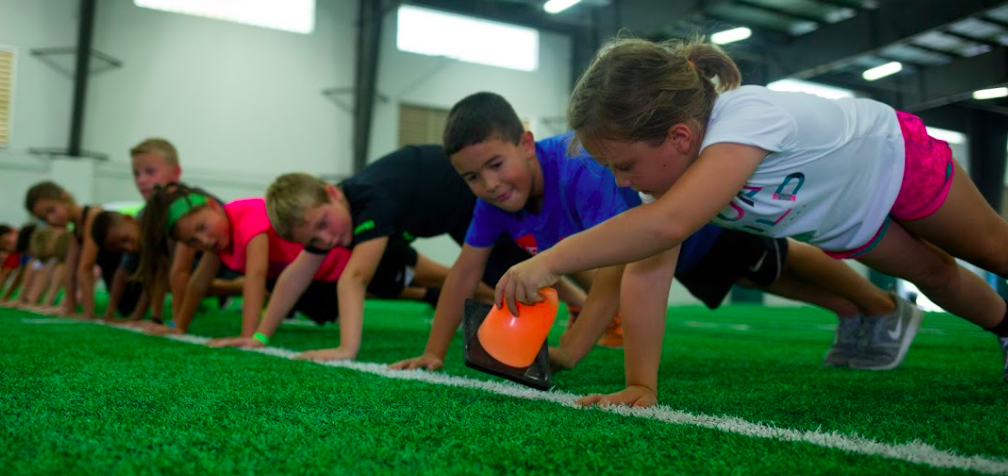Let Kids Play Again

Jeremiah Chapman CSCS, SCCC, Pn-1
We get a variety of questions from coaches, athletes, and parents alike when first learning about the different courses we offer. “How many days a week should I train?” “What should I be eating to gain weight?” “Is it going to interfere with our skills training?” “What is my kid going to learn?” These are just a few of the questions that come to mind while typing. These questions are understandable considering we are working with young athletes who may not have any training background. However, there is one concerning question that gets brought up repeatedly. “Will we be doing any (insert air quotes) ‘sport specific’ training?”
What does ‘sport specific’ mean?
The only way to truly have ‘sport specific’ training is to practice or play that sport. You need to dribble more to become better at dribbling. To make better contact with the ball you need to get in the cages and work on your timing. This seems obvious but with today’s marketing tactics and gimmicks everyone has a sport specific training program. Usually this means training with someone who previously played the sport and has since picked up a few pieces of gimmicky training equipment and markets themselves as the sport specific training guru. Training to become a better athlete universally looks the same across the board. Athletic development needs to focus on creating coordination, stability, mobility, strength and movement qualities that will improve performance and reduce the chance of injury. Improved force production through proper strength training will benefit all athletes. The ability to absorb force through coordinated movement and correct landing mechanics will help every athlete. Developing an aerobic engine that can provide athlete’s the necessary energy needed to sustain a practice or game, not to mention the ability to recover quicker between plays, is an advantage for any sport.
What makes a great athlete?
When asked the question, “what makes a great athlete”, most people will respond with similar answers. Someone who is stronger than their competition, quicker, they have more speed, they are in better shape, etc. An athlete, per Merriam-Webster is “a person who is trained in or good at games and exercises that require physical skill, endurance, and strength”. Physical skill, also known as, speed, power, agility, coordination along with endurance and strength is the dictionary definition of an athlete. None of the mentioned characteristics are specific to any one sport. Being strong will benefit a young tennis player just as much as it will an older baseball player. Being in better shape will benefit any athlete. Speed transfers to soccer just as well as it does to the football field. All athletes need to learn how to absorb force and change directions efficiently. Regardless of sport, bigger, stronger, mobile, and more adaptable athletes are going to be able to acquire new skills faster and apply them more effectively to their individual sports.
What is the strength coach’s role?
If you cut through allof the different training methods and modalities, you basically have two ways of training to become better for any sport: General Physical Preparation (GPP) or Specialized Physical Preparation (SPP). GPP is just as it sounds, general in nature and involves training athletic qualities. SPP involves playing, practice, or training a segmented movement to increase a sport related skill. At Performance Course, as strength and conditioning professionals, our job is to improve the overall physical qualities of the athlete. By developing proper movement and relative strength the athlete becomes more efficient and reduces the risk of injury. Now the individual sport coach can then take an athlete who moves better and work with them to improve their sport related skills. Better athlete + more developed sport skills = better (insert your favorite sport) player.
What is the role of training in youth sports?
Young athletes need to improve basic movement skills. Coordination, running, jumping, crawling, skipping, and increasing their aerobic capacity are general physical qualities that all beginner athletes should develop. Think of this as the base that they will build off of in the future. If an athlete has a narrow base, or a faulty foundation, their peak capabilities are going to be much lower than the athlete who has developed a wide, strong foundation. The younger the athlete the broader their training needs. Early sport specialization has led to an increasingly high rate of burnout and an increased risk injury. According to one recent study among 9-12-year-old baseball players, 26% were effected by some type of elbow pain. This pain was not associated with any type of acute or catastrophic injury but rather the cumulative effect due to the same repetitive motion over time.
Whether it is baseball, softball, volleyball, football, basketball or track, any movement repeatedly trained year-round without any time to recover, will eventually lead to issues. An emphasis must be placed on appropriate strength and conditioning protocols for young athletes, limiting the amount of repetitive movements, all while focusing on proper mechanics to avoid these problems. Young athletes need time to recover, periods of time to play other sports, and an off-season to train so we can combat overuse injuries or even worse burnout. Eventually as athletes mature they can start to narrow their focus towards their favorite sport. Even then, physical training should still be general in nature. As mentioned above, any athlete will benefit from gaining size, speed, strength, and endurance.
Kids need to play and have fun doing it. Allow time for them to recover, train, and explore new skills. This will lead to a more durable athlete and who knows, they may just find another sport to excel at in the future.
